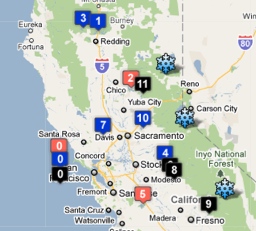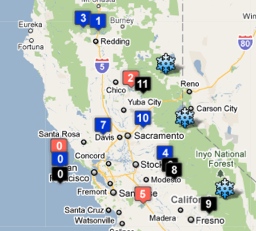A wet and wild February provided a huge boost to California’s water outlook
An unusually dry January started some folks thinking that maybe the tap had been shut off for this season. But last month winter came roaring back as Pacific storms brought epic snowfalls to the Sierra. The result: Today’s monthly survey shows the water content of the mountain snowpack at 124% of normal for this date–and even above its normal level for April first.

Major reservoirs are also above their normal levels for early March. But it still doesn’t mean that contractors on the State Water Project will get all the water they ask for. Officials say they still expect deliveries to come in at about 60% of the volume requested. That’s a number that typically gets adjusted throughout the winter.
We’ve updated our interactive map, showing the status of major reservoirs around the state.
View KQED: California Reservoir Watch in a larger map
Steve Nemeth, a Water resources engineer for DWR, says forecasts for spring runoff are equally cheery for virtually all Sierra watersheds, from the Yuba River south.
And another storm is due in tomorrow.
Of course, no silver lining would do without a dark cloud (that’s a bit confusing since in California, a dark cloud is a silver lining). The snow survey comes on the heels of a new report that suggests the long, long-term outlook for the southwestern US may be one of “periods of aridity lasting centuries to millennia,” if the distant past is prologue. The conclusions, based on studies of sediments from northern New Mexico, appears in the journal Nature.

2 thoughts on “Burgeoning Snowpack Sweetens Water Outlook”
Comments are closed.


“There’s a lot of debate about climate change, and we want some of it to happen here.”
So why don’t you include some of the blogs where debate is happening?
DeSmog Blog, Grist, Treehugger… You aren’t going to get any differing opinions there.
Climate Progress actually actively deletes and blocks comments by all but the most ardently faithful.
This is a public forum, created and paid for with tax dollars. The last thing it should be is ideologically 99 and 44/100ths percent pure, with the conversation dominated by a tiny, loud, and threatening minority.
The Corporation for Public Broadcasting “has invested more than $90 million in federal funds on new journalism initiatives. That includes a $10 million local journalism initiative that is paying for the creation of five regional centers that will help local PBS and NPR stations cover news that affects wider geographic areas.” – per the Huffington Post.
What did you buy with this profusion of federal money that a person couldn’t get on the streeet for free from a Bill McKibbon article in the News and Review?
About your dark cloud of century long droughts.
First of all, you have to click though to the New York Times article to find out that these sediment studies from northern New Mexico were extracted from a volcanic caldera.
Didn’t it strike you as odd that someone would go digging in an ancient and still active volcano for evidence of climate?
The Valles Caldera is a 22 kilometer wide prehistoric crater with an active geothermal system of hot springs and fumerals existing to this very day.
On top of taking core samples from the innards of a volcano, these “researchers” target for study the time frame when the ice sheet melted away from North America.
Do you think it’s a fair study to pick a time when the world was heating up [without co2] enough to erase ten mile thick ice sheets covering New York, then find a pleistocene volcano in the middle of a desert, and pretend like that has some sort of generalized climate condition representative of the Southwest?
I don’t doubt it was dry for centuries at a time in the Valles Caldera, during the pleistocene (end of the ice age), when the volcano was erupting on a regular basis. (It’s like “discovering” water is wet.)